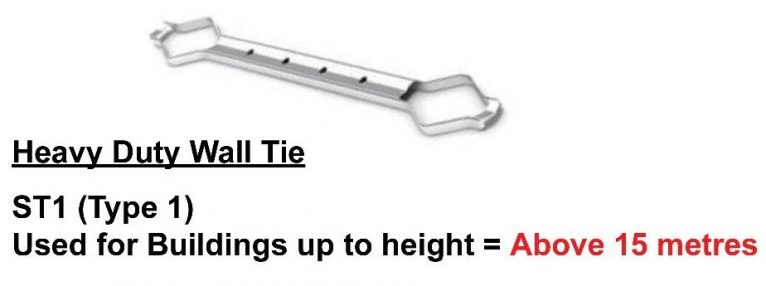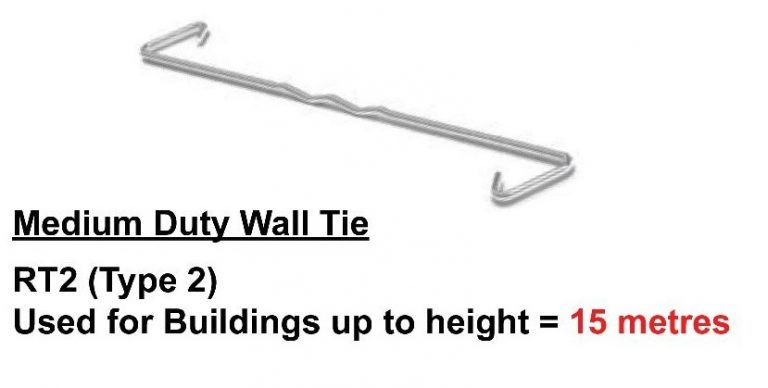What are the different types of wall tie?
There are many different types of wall ties available in builders merchants today that sometimes it can be difficult to know which is the most appropriate wall tie to use in your construction project. Wall ties are used in the construction industry in order to provide structure for buildings who are using cavity walls. The wall ties join the two walls together leading them to act as one homogenous unit and prevent a range of different issues which will result in the structural failure of the wall. In this article, we look at the different types of wall tie available and provide information on when and why you use each option.
Type 1 Wall Ties

The classification of wall ties is fairly simple to work out with the lower the type number, the higher duty the wall tie. So naturally, type 1 wall ties are the most heavy-duty wall ties available on the market. In construction, type 1 wall ties are the most commonly used wall tie for public and commercial buildings (especially high rises).
One of the main reasons for this is that the type 1 wall ties have been designed to not only meet, but exceed the strength requirements of the DD140: Part 2 regulations. This allows them to be used in the construction of any buildings throughout the UK, regardless of their height. Type 1 wall ties are not only designed for strength, they are also designed to prevent moisture passing across the body of the tie and are typically coated or manufactured from corrosion resistant materials.
Type 2 Wall Ties

As logic dictates, the type 2 wall ties are not as heavy duty as type 1 wall ties. However, they are probably the most commonly used wall ties in general construction work that includes domestic and small commercial buildings. The type 2 wall ties are strong in their own right and are suitable for use in buildings up to 15 meters in height (or 3 storeys). They also have a reasonably good length and can be used to join the two leaves of masonry walls with cavities up to 100mm.
Type 3 Wall Ties
There are also type 3 wall ties, which are not that commonly used in the construction industry. The type 3 is a fairly standard wall tie and will be sufficient to tie two masonry leaves together in small projects. Examples of where you may use type 3 wall ties include domestic or commercial projects whereby buildings do not exceed 15 meters in height and in a location where the average wind speed is below 25m/s. At Wonkee Donkee, we would recommend that type 3 wall ties should only be used if type 2 or 4 wall ties are unavailable as there is no real advantage of choosing a type 3 over a type 2 in regard to strength, or a type 3 over a type 4 in regard to availability and compatibility.
Type 4 Wall Ties

The type 4 wall tie is the lightest duty of wall tie that is used in order to join two masonry leaves together. Due to the fact they are a much lighter duty wall tie, it can only be used in domestic construction projects whereby the building does not exceed 10 meters in height. The type 4 wall ties meet the BSEN 845-1 regulations for wall cavities up to 100mm.
What other wall ties exist?
There are a whole load of other wall ties that are available to purchase from builders merchants and each of them are uniquely designed to complete a different task. Below are a few examples of other wall ties and what they have been innovatively designed to do:
Column Wall Ties
Just as timber frame ties are best specifically designed to work with timber frames, column wall ties are specifically built in order to fix masonry walls to steel frames. The process of attaching wall ties to steel frames can be very time consuming as it requires drilling and bolting of each individual tie. The unique thing about column wall ties is that it removes the drilling and bolting process and they are able to be used with various profile types of steel column.
Channel Ties
Channel tiles are unique as they have a dovetail design. They are manufactured by ACS and the design works perfectly with other ACS products such as the ACS Axis channel. However, they are also compatible with other brands’ products so do not rule them out if you are using other materials from different suppliers. The purpose of a channel tie is to connect masonry brickwork with a range of other building materials, including concrete slab, steel frames or timber frames.
Movement Wall Ties
If the building you are constructing is unique or if you are predicting potential lateral movement upon completion, then movement wall ties provide a reasonable amount of ‘give’ which allows the building to move slightly without issue. Typically movement ties allow for a movement of 10mm, achieving this through one side of the tie being in a fixed position and the other fitting within a debonding sleeve. The innovative design of this sleeve allows the wall tie to provide lateral movement with ease if required. Movement wall ties are still embedded into the mortar, this is what restricts the lateral movement of up to 10mm.






